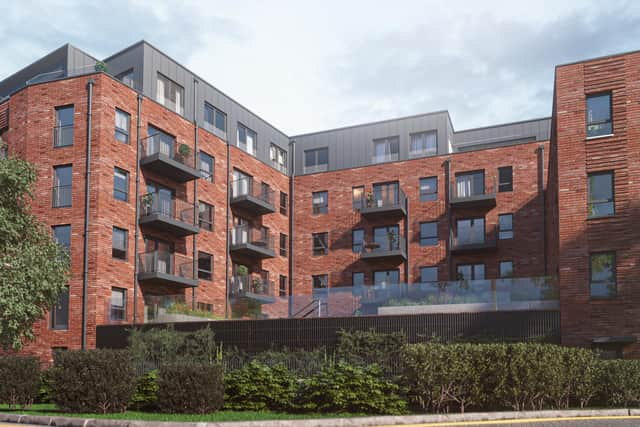Interview: Andrew Duncan, land director at Glasgow-based developer Kelvin Properties
Andrew Duncan is land director at Kelvin Properties, a developer that says it turns underused brownfield sites and historic buildings into residential communities. While its developments have since its formation in 1999 mainly been in its native Glasgow, it has been expanding east with the likes of the forthcoming 67 St. Bernards project in Edinburgh’s Canonmills.
Duncan says his favourite subject at school was geography, and his teacher of that class told him to get into the property profession, prompting him to get a real estate degree at the University of Aberdeen, followed by roles at major Scottish names in the sector Springfield Properties and Cala Homes. He joined Kelvin Properties in 2021, and said its offering appealed as he has always been interested in regeneration and bespoke development. “It’s really not long since we started at 67 St. Bernards, and I’m now able to stand at the penthouse level and look across the Edinburgh skyline,” he says.
Advertisement
Hide AdAdvertisement
Hide AdThis year marks the firm’s 25th anniversary – what have been key milestones to date?


Particular highlights include reviving Sandringham Court in Newton Mearns, driving Glasgow’s first build-to-rent (BTR) development, Candleriggs Court in the Merchant City, and The Atrium, the listed Broomhill Public School building. Driving such exceptional demand for Waverley Park in Shawlands, with more than 1,000 applicants registering interest, was also fantastic. There has been a similar appetite for 67 St. Bernards, our first development in Edinburgh.
We are now in an exciting period of growth, and are passionate about the delivery of high-quality developments in Glasgow and across central Scotland. We experienced another major milestone when we moved into our Glasgow city-centre office in summer 2022.
Kelvin Properties has said it has “lots in the pipeline for 2024”. Can you outline such plans, including more potential activity in the east of Scotland?
Edinburgh’s really exciting for us – especially given the appetite for 67 St. Bernards, which will complete in June this year. The lack of supply of new homes in the city is a key reason why our first Edinburgh development has had so much interest.


It’s been great to help regenerate a former industrial site into what will be a thriving residential community. We’re eager to develop a longer-term sustainable pipeline in Edinburgh, and we’ve been having conversations to find our next big project in the city, whether that’s private for sale, BTR, or purpose-built student accommodation (PBSA).
How can your work creating new homes plus broader efforts by local authorities help make Scottish city centres more liveable?
While there’s exceptionally high demand for city-centre properties in Edinburgh, Glasgow is undergoing a repositioning, and there’s a lot of work required to attract developers to the city centre through the improvement of key public facilities like doctors and schools. Edinburgh has recently declared a housing emergency, yet there have still been several residential-led applications recently refused, but we feel all residential applications are key in tackling the acute shortage of homes.
Advertisement
Hide AdAdvertisement
Hide AdWe are actively looking for sites in both cities, as demonstrated by our recent application for the B-listed Mount building in Garnethill, a historic former school and hospital building that will create 21 rental properties in Glasgow city centre. We hope to be on site with this development come summer this year.
What is your outlook for the BTR sector in Scotland?
Our longer-term outlook for BTR remains extremely positive. The depth of demand for the product is evidently still there in both Edinburgh and Glasgow. Both were among the cities with the highest rent increases in the UK last year, which we don't see as a positive thing, and only underlines the significant constrained supply of new rental property in both.
Our longer-term vision is still to do more BTR in Scotland, and we hope the longer-term rent control legislation enables investment back into the Scottish market. The take-up for our recent BTR developments in Merchant City and Finnieston has been phenomenal.
However, investment within the BTR sector all depends on the outcome of the housing bill paper due to be released in the spring. That will have a colossal impact on the industry across Scotland, whose development is dependent on investment from large funds who have recently shied away from Scottish projects due, largely, to stringent rent control policies.
What impact has Kelvin Properties been seeing from the troubled economic backdrop/skills shortages/issues around the planning process? And what effect have you seen in the property sector from the collapse of Scottish housebuilder Stewart Milne?
The demise of a number of developers just shows how slim margins can be, and how exposed they can be to challenges across the market. When the market turns, a development that has already absorbed significant investment in both money and time can become unviable very quickly. Also, the delivery of new homes cannot happen without a high performing planning department where they meet key performance indicators and can help to accelerate planning consents, but there have been such vast cuts to budgets and staff numbers.
Even once developers do get on site, they now have to navigate the challenges associated with the supply chain and the clear skills shortage that is in part a result of a large segment of the workforce returning to mainland Europe as a result of Brexit.
Can you give details of your sustainability strategy?
A big focus of our business is on conversion projects. Reusing an existing building is the greatest sustainability measure you can take, due to the embodied carbon in the building itself. We recently lodged an application to convert a B-listed building in Garnethill to 21 apartments, and we’re looking at similar projects across central Scotland. Our future developments are all seeing modern energy-saving solutions incorporated, but we always look to make it as sustainable as possible while still making it affordable to run and to live in for buyers and renters.
Comments
Want to join the conversation? Please or to comment on this article.